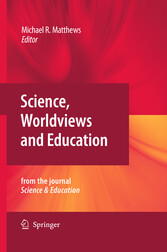Suchen und Finden
Contents
5
Preface
6
Science, Worldviews and Education: An Introduction
9
1 Introduction
9
2 Debate About the Nature of Science (NOS)
12
3 Culture and Worldviews
13
4 Science and Worldviews
17
5 Nature of Science and Worldviews in Science Curricula
19
6 Contributions to this Volume
23
7 Conclusion
31
References
31
Author Biography
33
Science, Worldviews, and Education
35
1 Introduction
36
2 A Spectrum of Opinions
36
3 Stipulatory and Substantive Issues
39
4 Seven Pillars of Science
40
5 Scientific Method
41
6 The Testability of Worldviews
45
8 Necessary and Unnecessary Presuppositions
51
9 Conclusions
53
References
54
Teaching the Philosophical and Worldview Components of Science
57
1 Introduction
57
2 Science and Philosophy
61
3 Science and Metaphysics
64
4 Science and Worldviews
67
5 Worldviews and the Scientific Revolution
68
6 The Logic of Atomism
74
7 When Worldviews Collide: The Atomistic Heresy
75
8 The Survival of Scholasticism
78
9 Options for Reconciling Worldviews
80
10 Conclusion
82
References
83
Author Biography
88
Worldviews and their relation to science
89
1 Introduction
89
2 What is a worldview?
90
3 Gauch’s seven pillars of science
95
4 Do the pillars of science have any worldview content?
96
5 Criticism and the mode of scientific explanation as sources of worldview import
99
6 Worldviews and multiculturalism: some implications for science education
102
7 Conclusion
103
References
104
Contemporary Science and Worldview-Making
106
1 Introduction
107
2 The Compelling Part of Science
109
3 What’s within Reach?
111
4 Science’s Epistemic Arrow
112
5 Teleology, Now?
114
6 Competition between Worldviews
118
References
122
The Electromagnetic Conception of Nature at the Root of the Special and General Relativity Theories and its Revolutionary Meaning
124
1 Introduction: Conceptions of Nature
124
2 Electromagnetic Conception of Nature and Special Relativity
127
3 Einstein, Hilbert and the Origins of the General Relativity Theory
128
4 Einstein’s Cosmic Religion and Hilbert’s Worldview
132
5 Conclusions: Science Education and Worldviews
137
References
138
Imagining the World: The Significance of Religious Worldviews for Science Education
141
1 The Relationship between Science and Religion
142
2 Scientific and Religious Understandings of Biodiversity
144
3 March of the Penguins
145
4 And Tango Makes Three
148
5 Possible Ways Forward When Teaching School Science
150
References
152
Whose Science and Whose Religion? Reflections on the Relations between Scientific and Religious Worldviews
155
1 Introduction
156
2 Some Preliminaries on the Nature of Science
157
3 Five Questions
158
4 Conclusion
168
References
169
Can Science Test Supernatural Worldviews?
171
1 Major Scientific Institutions Claim That Science Cannot Test Supernatural Worldviews
172
2 Science Can Test Supernatural Claims: A Bayesian Perspective
173
3 Believing ‘‘On Faith’’
183
4 NOMA Again
185
5 Natural Psychological Explanations for the Origin and Persistence of Supernatural Worldviews
186
6 Going Wherever the Evidence Leads
187
7 Science Does Not Presuppose Naturalism. Whether or Not the Supernatural Exists Is an Empirical Question
188
8 Implications and Challenges for Science Education
190
References
192
The Interplay of Scientific Activity, Worldviews and Value Outlooks
196
1 Introduction
196
2 ‘‘Scientific Activity,’’ ‘‘Worldviews,’’ ‘‘Value Outlooks’’
197
3 The ‘‘Scientific’’ Worldview and the Values of Technological Progress
199
4 Costs of Privileging the Decontextualized Approach
208
5 Conclusion
214
References
216
Fall and Rise of Aristotelian Metaphysics in the Philosophy of Science
218
1 The Enlightenment Dismissal of Aristotelian Metaphysics, and its Neo-Aristotelian Opponents
218
2 Historical Reconsiderations of the Role of Aristotelianism in Science
220
3 The Scientific Revolution and Aristotelian Metaphysics
223
4 Hume, Positivism, and the Eclipse of Aristotelianism
231
5 Rebirth of Aristotelianism in the Philosophy of Science
235
References
238
Modern Science and Conservative Islam: An Uneasy Relationship
242
1 Introduction
242
2 Resisting Evolution
243
3 Creationism in Turkey
246
4 Varieties of Creationism
248
5 Partial Acceptance of Evolution
251
6 Created Nature
253
7 An Illusion of Harmony
255
8 Conclusion
258
References
258
Science and worldviews in the marxist tradition
261
1 Introduction
261
2 Science: Materialist Ontology, Realist Epistemology, Social Activity
263
3 The Theoretical Landscape of Marxism
264
4 Marx’s Encounter with Natural Philosophy and Materialism
266
5 Marx’s Science-Realism
267
6 Science as Social Activity: The Conceptual Autonomy of Science
269
7 Marxism among the Scientists. Implications for Science Education
270
References
272
Science and Worldviews in the Classroom: Joseph Priestley and Photosynthesis
274
1 Introduction
274
2 Some Appraisals of Priestley
276
3 Priestley’s Life
277
4 Priestley’s Publications
279
5 Priestley and the Enlightenment
279
6 The Philosophical and Experimental Path to Photosynthesis (‘The Restoration of Air’)
282
7 Priestley’s First Steps towards the Discovery of Photosynthesis
285
8 Priestley’s Final Steps Towards Photosynthesis
290
9 Priestley’s Providential Worldview
293
10 Priestley in the Classroom
296
11 Conclusion
300
References
301
Responses and Clarifications Regarding Science and Worldviews
306
1 Introduction
306
2 Worldview Reasoning
307
3 Worldview Evidence
310
4 Worldview Convictions
319
5 Additional Responses and Clarifications
322
6 Seven Questions for the AAAS and NAS
326
7 Conclusions
327
References
327
Author Index
329
Subject Index
336
Alle Preise verstehen sich inklusive der gesetzlichen MwSt.








